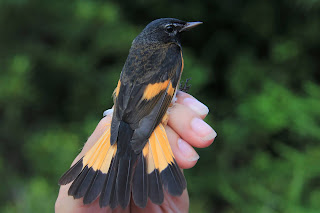Captain Sam's:
Today at Captain Sam's, we saw a dip in the production of the last few days. This gave us time to look at some interesting species and learn more specifics about aging and sexing. The most fascinating bird from today was our only empidonax flycatcher. This is a group of flycatchers that all resemble each other in the field. Often times, vocalizations are the only reliable way to identify them if not banding. Upon bringing the bird back, I had a pretty good idea that this bird was a "Traill's" Flycatcher, and was hoping that we could identify it a step further. Originally, Traill's was its own species, but has since been split into alder and willow flycatcher. Vocally, the two are distinct, and measurements can sometimes separate the species in the hand. However, many like our bird fall in a gray area and are left as "traill's".
We took many different measurements such as the longest primary to the longest secondary, the difference in length between the 6th and 9th primary, and so on. None of it was conclusive enough to identify the species... If only it had sung. We were able to age this bird as a hatch-year due to the buffy greater coverts. These would be much whiter on an adult bird.
 |
| Hatch-year unknown "Traill's" Flycatcher |
The last few days we have been catching three very young painted buntings. Fairly recent fledglings still growing in their juvenile plumage. I nicknamed them the "triplets" as they all look identical and seem to fall into the same net pockets together. I'm really excited to watch these young birds grow and eventually (sadly) leave Captain Sam's.
Although the winds look to be pushing in from the East in the next few days, I am hopeful that we'll be able to catch some more fun birds.
-Ben
Little Bear:
With the shifting weather patterns, and having had a slower day at the station yesterday, expectations were pretty low as we opened nets at Little Bear this morning. But the nice thing about low expectations is that they're easily exceeded, and that's exactly what ended up happening. We ended with a modest total of 28 birds captured, and had a few nice highlights, such as our second-of-the-season Eastern Kingbird (just us uncooperative for photos as the first), and a more photogenic adult male American Redstart. The 'frosty' white and orange tips to the body feathers is fairly common on adult male Redstarts that have recently finished molting (replacing feathers before migrating). These feather tips will wear off during the winter, resulting in the jet-black and orange birds that are depicted in your field guide, and seen during the spring and summer.
 |
| Adult male American Redstart |
-Josh
| Species | Captain Sam's | Little Bear | ||
|---|---|---|---|---|
| New | Recaps | New | Recaps | |
Downy Woodpecker | - | 1 | 2 | - |
Great-crested Flycatcher | - | 1 | - | - |
Eastern Kingbird | - | - | 1 | - |
Traill's Flycatcher | 1 | - | - | - |
Red-eyed Vireo | 2 | - | - | - |
Carolina Wren | 1 | 1 | 2 | 3 |
Ovenbird | - | - | 1 | - |
Northern Waterthrush | - | - | 3 | - |
Black-and-white Warbler | 1 | - | - | - |
American Redstart | - | 1 | 2 | - |
Prairie Warbler | 8 | - | 4 | - |
Northern Cardinal | - | - | 4 | 4 |
| Painted Bunting | - | 1 | 1 | 1 |
| Today's Banding Stats | Captain Sam's | Little Bear | TOTAL |
|---|---|---|---|
| # Birds Banded | 13 | 20 | 33 |
| # of Recaptures | 5 | 8 | 13 |
| # of Species | 9 | 9 | 12 |
| Effort (net-hours) | 135 | 101.2 | 236.2 |
| Capture Rate (birds/100 net-hours) | 13.3 | 27.7 | 19.5 |
| # of Nets | 30 | 23 | 53 |
| 2021 Fall Cumulative Banding Stats | Captain Sam's | Little Bear | TOTAL |
|---|---|---|---|
| # Birds Banded | 202 | 114 | 316 |
| # of Recaptures | 56 | 19 | 75 |
| # of Species | 31 | 23 | 38 |
| Effort (net-hours) | 1441.5 | 569.25 | 2010.75 |
| Capture Rate (birds/100 net-hours) | 17.9 | 23.4 | 19.4 |
| # of Days | 10 | 5 | - |
Banding Staff
